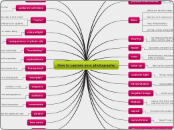How to capture your photography
color
lead eye to idea
physical environment
setting and photograph are one and the same
lines
define and describe edges
lead eye as it explores an image
many interpretations
curving: motion and growth
sharing
not keeping to the photographer, rather allowing to present others with the idea or concept
mood
illuminates character of the photography
color
with technology, the photographer can choose the colors (keep or change)
close-up
later can be explored in detail
avaliable light
"brings beauty out of the darkness"
interpretation
representation
negative image
create a positive image on paper base
rhetors
capture what the photographer wants to capture, rather than what they think the audience will want
appeal
what draws the audience into the photograph
monochrome
"classic" look in black and white
different areas affect how they are captured
weddings, advertising, editorial, visual art, fashion, etc.
flash
object sizes
point of idea and what is actually being focused
audience perceives
make the audience feel what the photographer felt when capturing the photograph
"scene"
made ready in that instant
continue to be captured
natural light
taking advantage of the gifts of nature or what is being captured
transparency of photo oils
(black and white) allows details to come through the image
"bracketing"
testing exposures and only visible light
equivalences
within the surroundings and relating them and having them show through in the photograph
transparent
imagine beyond what is in front of us
"everyday"
modernity and history of photography
exigence
condition or idea
audience
capture what the audience wants the phtoographer to capture
constraints
what is limiting the photographer
control
photgrapher captures what they want the audience to see
